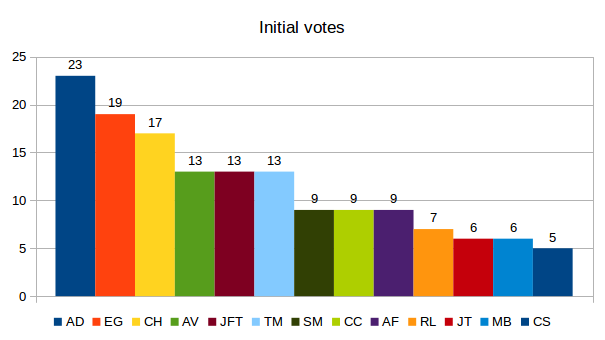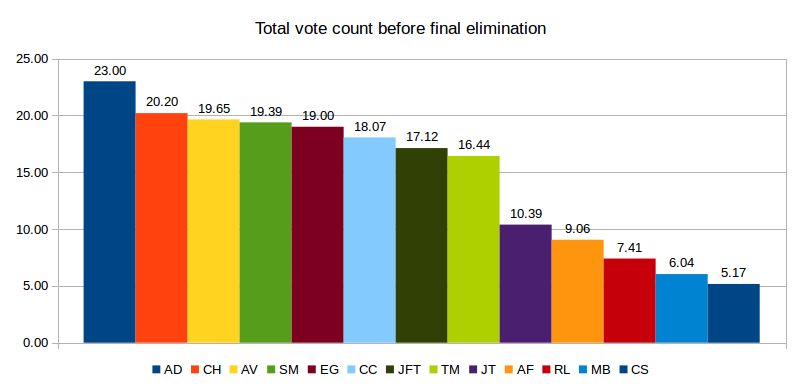On 2015-10-04 it was announced that the governing body of the GNOME Foundation, the Board, has a vacant seat. That body was elected about 15 weeks earlier. The elections are very democratic, they use an STV system to make as many votes as possible count. So far, no replacement has been officially announced. The question of what strategy to use in order to find the replacement has been left unanswered. Let me summarise the facts and comment on the strategy I wish the GNOME project to follow.
The STV system used can be a bit hard to comprehend, at first, so let me show you the effects of an STV system based on the last GNOME elections. With STV systems, the electorate can vote for more than one candidate. An algorithm then determines how to split up the votes, if necessary. Let’s have a look at the last election’s first votes:
We see the initial votes, that is, the number of ballots in which a candidate was chosen first. If a candidate gets eliminated, either because the number of votes is sufficient to get elected or because the candidate has the least votes and cannot be elected anymore, the vote of the ballot is being transferred onto the next candidate.
In the chart we see that the electorate chose to place 19 or more votes onto two candidates who got directly elected. Overall, six candidates have received 13 or more votes. Other candidates have at least 30% less votes than that. If we had a “simple” voting mechanism, the result would be the seven candidates with the most votes. I would have been one of them.
But that’s not how our voting system works, because, as we can see below, the picture of accumulated votes looks differently just before eliminating the last candidate (i.e. me):
If you compare the top seven now, you observe that one candidate received votes from other candidates who got eliminated and managed to get in.
We can also see from the result that the final seat was given to 17.12 votes and that the first runner-up had 16.44 votes. So this is quite close. The second runner-up received 10.39 votes, or 63% of the votes of the first runner-up (so the first runner-up received 158% of the votes of the second runner-up).
We can also visually identify this effect by observing a group of eight which accumulated the lion’s share of the votes. It is followed by a group of five.
Now one out of the seven elected candidates needed to drop out, creating a vacancy. The Foundation has a set of rules, the bylaws, which regulate vacancies. They are pretty much geared towards maintaining an operational state even with a few directors left and do not mandate any particular behaviour, especially not to follow the latest election results.
But.
Of course this is not about what is legally possible, because that’s the baseline, the bare minimum we expect to see. The GNOME Foundation’s Board is one of the few democratically elected bodies. It is a well respected entity in industry as well as other Free Software communities. I want it to stay that way. Most things in Free Software are not very democratic; and that’s perfectly fine. But we chose to have a very democratic system around the governing body and I think that it would leave a bad taste if the GNOME Foundation chooses to not follow these rather young election results. I believe that its reputation can be damaged if the impression of forming a cabal, of not listening to its own membership, prevails. I interpret the results as a strong statement of its membership for those eight candidates. GNOME already has to struggle with accusations of it not listening to its users. I’d rather want to get rid of it, not fueling it by extending it to its electorate. We’re in the process of acquiring sponsors for our events and I don’t think it’s received well if the body ignores its own processes. I’d also rather value the membership more rather than producing arguments for those members who chose to not vote at all and try to increase the number of members who actually vote.


